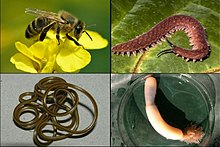
Back Ecdysozoa Afrikaans انسلاخيات Arabic انسلاخيات ARZ Ecdysozoa AST Tüləyənlər Azerbaijani Ecdysozoa Byelorussian Ecdysozoa Bulgarian Ecdysozoa BS Ecdisozous Catalan Ecdysozoa Czech
| Ecdysozoa Temporal range: Possible traces age 556 Ma[1]
| |
|---|---|

| |
| Scientific classification | |
| Domain: | Eukaryota |
| Kingdom: | Animalia |
| Subkingdom: | Eumetazoa |
| Clade: | ParaHoxozoa |
| Clade: | Bilateria |
| Clade: | Nephrozoa |
| (unranked): | Protostomia |
| Superphylum: | Ecdysozoa Aguinaldo et al., 1997 |
| Phyla | |
Ecdysozoa (/ˌɛkdɪsoʊˈzoʊə/) is a group of protostome animals,[4] including Arthropoda (insects, chelicerata (including arachnids), crustaceans, and myriapods), Nematoda, and several smaller phyla. The grouping of these animal phyla into a single clade was first proposed by Eernisse et al. (1992) based on a phylogenetic analysis of 141 morphological characters of ultrastructural and embryological phenotypes.[5] This clade, that is, a group consisting of a common ancestor and all its descendants, was formally named by Aguinaldo et al. in 1997, based mainly on phylogenetic trees constructed using 18S ribosomal RNA genes.[6]
A large study in 2008 by Dunn et al. strongly supported the monophyly of Ecdysozoa.[7]
The group Ecdysozoa is supported by many morphological characters, including growth by ecdysis, with moulting of the cuticle – without mitosis in the epidermis – under control of the prohormone ecdysone, and internal fertilization.[8]
The group was initially contested by a significant minority of biologists. Some argued for groupings based on more traditional taxonomic techniques,[9] while others contested the interpretation of the molecular data.[10][11]
- ^ a b Howard RJ, Giacomelli M, Lozano-Fernandez J, Edgecombe GD, Fleming JF, Kristensen RM, et al. (2022). "The Ediacaran origin of ecdysozoa: Integrating fossil and phylogenomic data". Journal of the Geological Society. 179 (4). Bibcode:2022JGSoc.179..107H. doi:10.1144/jgs2021-107. hdl:2445/186596. S2CID 246494357. Retrieved 2023-07-30.
- ^ Liu, Yunhuan; Carlisle, Emily; Zhang, Huaqiao; Yang, Ben; Steiner, Michael; Shao, Tiequan; et al. (17 August 2022). "Saccorhytus is an early ecdysozoan, and not the earliest deuterostome". Nature. 609 (7927): 541–546. Bibcode:2022Natur.609..541L. doi:10.1038/s41586-022-05107-z. hdl:1983/454e7bec-4cd4-4121-933e-abeab69e96c1. ISSN 1476-4687. PMID 35978194. S2CID 251646316.
- ^ Howard, Richard J.; Edgecombe, Gregory D.; Shi, Xiaomei; Hou, Xianguang; Ma, Xiaoya (23 November 2020). "Ancestral morphology of Ecdysozoa constrained by an early Cambrian stem group ecdysozoan". BMC Evolutionary Biology. 20 (1): 156. doi:10.1186/s12862-020-01720-6. ISSN 1471-2148. PMC 7684930. PMID 33228518.
- ^ Telford, Maximilian J.; Bourlat, Sarah J.; Economou, Andrew; Papillon, Daniel; Rota-Stabelli, Omar (2008). "The evolution of the Ecdysozoa". Philosophical Transactions of the Royal Society B: Biological Sciences. 363 (1496): 1529–1537. doi:10.1098/rstb.2007.2243. ISSN 0962-8436. PMC 2614232. PMID 18192181.
- ^ Eernisse, D.J.; Albert, J.S.; Anderson, F.E. (1992). "Annelida and Arthropoda are not sister taxa: A phylogenetic analysis of spiralian metazoan morphology". Systematic Biology. 41 (3): 305–330. doi:10.1093/sysbio/41.3.305.
- ^ Aguinaldo, A.M.A.; Turbeville, J.M.; Linford, L.S.; Rivera, M.C.; Garey, J.R.; Raff, R.A.; Lake, J.A. (29 May 1997). "Evidence for a clade of nematodes, arthropods, and other moulting animals". Nature. 387 (6632): 489–493. Bibcode:1997Natur.387R.489A. doi:10.1038/387489a0. PMID 9168109. S2CID 4334033.
- ^ Dunn, C.W.; Hejnol, A.; Matus, D.Q.; Pang, K.; Browne, W.E.; Smith, S.A.; et al. (10 April 2008). "Broad phylogenomic sampling improves resolution of the animal tree of life". Nature. 452 (7188): 745–749. Bibcode:2008Natur.452..745D. doi:10.1038/nature06614. PMID 18322464. S2CID 4397099.
- ^ Ax, P. (1985). "The position of the Gnathostomulida and Platyhelminthes in the phylogenetic system of the Bilateria". In Conway Morris, S.; George, J.D.; Gibson, R.; Platt, H.M. (eds.). The Origins and Relationships of Lower Invertebrates. Systematics Association Special Volume. Vol. 28. New York, NY: Clarendon / Oxford University Press. pp. 168–180. ISBN 019857181X. OCLC 59186778 – via Internet Archive (archive.org).
proceedings of an international symposium held in London, September 1983
ISBN 9780198571810 - ^ Nielsen, Claus (1995). Animal Evolution: Interrelationships of the living phyla. Oxford University Press. ISBN 978-0-19-850682-9.
- ^ Blair, J.E.; Ikeo, Kazuho; Gojobori, Takashi; Hedges, S. Blair (8 April 2002). "The evolutionary position of nematodes". BMC Evolutionary Biology. 2: 7. doi:10.1186/1471-2148-2-7. PMC 102755. PMID 11985779.
- ^ Wägele, J.W.; Erikson, T.; Lockhart, P.; Misof, B. (December 1999). "The Ecdysozoa: Artifact or monophylum?". Journal of Zoological Systematics and Evolutionary Research. 37 (4): 211–223. doi:10.1111/j.1439-0469.1999.tb00985.x.
© MMXXIII Rich X Search. We shall prevail. All rights reserved. Rich X Search